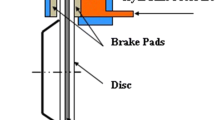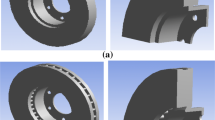Abstract
Braking system is one of the important control systems of an automotive. For many years, the disc brakes have been used in automobiles for the safe retarding of the vehicles. During the braking enormous amount of heat will be generated and for effective braking sufficient heat dissipation is essential. The thermal performance of disc brake depends upon the characteristics of the airflow around the brake rotor and hence the aerodynamics is an important in the region of brake components. A CFD analysis is carried out on the braking system as a case study to make out the behaviour of airflow distribution around the disc brake components using ANSYS CFX software. We are interested in the determination of the heat transfer coefficient on each surface of a ventilated disc rotor varying with time in a transient state using CFD analysis, and then imported the surface film condition data into a corresponding FEM model for disc temperature analysis.



































Similar content being viewed by others
References
Paredes, M., Daidié, A.: Optimal catalogue selection and custom design of belleville spring arrangements. Int. J. Interact. Des. Manuf. 4(1), 51–59 (2010)
Paredes, M.: Methodology to build an assistance tool dedicated to preliminary design: application to compression springs. Int. J. Interact. Des. Manuf. 3, 265–272 (2009)
Valvano, T., Lee, K.:An analytical method to predict thermal distortion of a brake rotor. SAE Paper 2000-01-0445 (2000)
Johnson, D.A., Sperandei, B.A., Gilbert, R.: Analysis of the flow through a vented automotive brake rotor, ASME. J. Fluids Eng. 125, 979–986 (2003)
Jerhamre,A ., Bergstrom, C.: Numerical study of brake disc cooling accounting for both aerodynamic drag force and cooling efficiency. SAE 2001-01-0948 (2001)
Voller, G.P., Tirovic, M., Morris, R., Gibbens, P.: Analysis of automotive disc brake cooling characteristics. Proc. Inst. Mech. Eng. Part D J. Automob. Eng. 217, 657–666 (2003)
Wallis, L., Leonardi, E., Milton, B.: Air flow and heat transfer in ventilated disc brake rotors with diamond and tear-drop pillars. Numer. Heat Trans. Part A 41, 643–655 (2002)
Hudson, D., Ruhl, R.L.: Ventilated brake rotor air flow investigation. SAE 971033 (1997)
Valvano, T., Lee, K.: An analytical method to predict thermal distortion of a brake rotor. SAE 2000-01-0445(2000)
Eisengraber, R., Grochowicz, J., Schuster, M., Augsburg, K., Kock, L.: Comparison of different methods for the determination of the friction temperature of disc brakes. SAE 1999-01-0132(1999)
Parish, D., MacManus, D.G.: Aerodynamic investigations of ventilated brake discs. Proc. Inst. Mech. Eng. Part D J. Automob. Eng. 219, 471–486 (2005)
Anderson, A.E., Knapp, R.A.: Hot Spotting in Automotive Friction Systems. Wear 135, 319–337 (1990)
Lee, K., Dinwiddie, R.B.: Conditions of frictional contact in disk brakes and their effects on brake judder. SAE 980598 (1998)
Abu Bakar, A.R., Ouyang, H., Chiing, L., Khaia, D., Mohd Shahrulizam, A.: Thermal analysis of a disc brake model considering a real brake pad surface and wear. Int. J. Veh. Struct. Syst. 2(1), 20–27 (2010)
Dufrénoy, P.: Two-/three-dimensional hybrid model of the thermomechanical behaviour of disc brakes? J Rail Rapid Transit Part F 218, 17–30 (2004)
Söderberg, A., Andersson, S.: Simulation of wear and contact pressure distribution at the pad to-rotor interface, in the disc brake using general purpose finite element analysis software. Wear 267 12(1), 2243–2251 (2009)
Voldrich, J.: Frictionally excited thermoelastic instability indisc brakes—transient problem in the full contact regime. Int. J. Mech. Sci. 49(2), 129–137 (2006)
Gao, C.H., Lin, X.Z.: Transient temperature field analysis of a brake in a non- axisymmetric three-dimensional model. J. Mater. Process. Technol. 129, 513–517 (2002)
Lee, S., Yeo, T.: Temperature and coning analysis of brake rotor using an axisymmetric finite element technique. Proc. 4th Korea–Russia Int. Symp. Sci. Technol. 3, 17–22 (2000)
Ouyang, H., Abu Bakar, A.R., Li, L.: A combined analysis of heat conduction, contact pressure and transient vibration of a disc brake. Int. J. Veh. Des. 51(1/2), 190–206 (2009)
Belhocine, A., Nouby, M.G.: Effects of Young’s modulus on disc brake squeal using finite element analysis. Int. J. Acoust. Vib. 21(3), 292–300 (2016)
Hassan, M.Z., Brooks, P.C., Barton, D.C.: A predictive tool to evaluate disk brake squeal using a fully coupled thermo-mechanical finite element model. Int. J. Veh. Des. 51(1/2), 124–142 (2009)
Sivarao, M.A., Rizal, M.S., Kamely, A.: An investigation toward development of economical brake lining wear alert system. Int. J. Eng. Technol. 9(9), 251–256 (2009)
Kuciej, M., Grzes, P.: The comparable analysis of temperature distributions assessment in disc brake obtained using analytical method and FE model. J Kones Powertrain Transp. 18(2), 236–250 (2011)
Cho, C., Ahn, S.: Thermo-elastic analysis for chattering phenomenon of automotive disk brake. KSME Int. J. 15(5), 569–579 (2001)
Belhocine, A., Wan Omar, W.Z.: Predictive modeling and simulation of the structural contact problems between the brake pads and rotor in frictional sliding contact. Int. J. Interact. Des. Manuf., 1–18 (2017). doi:10.1007/s12008-017-0376-1
Belhocine, A.: FE prediction of thermal performance and stresses in an automotive disc brake system. Int. J. Adv. Manuf. Technol. 89(9), 3563–3578 (2017)
Zhang, L., Yang, Q., Weichert, D., Tan, N.: Simulation and analysis of thermal fatigue based on imperfection model of brake discs, Beijing Jiaotong University, PAMM. Proc. Appl. Math. Mech. 9, 533–534 (2009)
Reimpel, J.: Braking Technology. Vogel Verlag, Würzburg (1998)
Cruceanu, C.: Frâne pentru vehicle feroviare (Brakes for Railway Vehicles), Ed. MATRIXROM, Bucureşti, ISBN 978-973-755-200-6, 388 (2007)
Gotowicki, P.F., Vinzenco, N., Mariotti, G.V.: Numerical and experimental analysis of a pegs- wing ventilated disk brake rotor, with pads and cylinders, 10th EAEC Eur. Automot. Cong.– Paper EAEC05YUAS04– P, vol. 5, June (2005)
Khalid, M.K., Mansor, M.R., Abdul Kudus, S.I., Tahir, M.M., Hassan, M.Z.: Performance investigation of the UTeM eco-car disc brake system. Int. J. Eng. Technol. 11(06), 1–6 (2011)
Limpert, R.: Brake Design and Safety, 2nd edn, pp. 137–144. Society of Automotive Engineering Inc, Warrendale (1999)
Dittrich, H., Lang, R.: Finite-element analysis of the thermal loads acting on a passenger car brake disk. Automob. Z. 86(6), 265–269 (1984)
Fukano, A., Matsui, H.: Development of disc-brake design method using computer simulation of heat phenomena. SAE 860634 (1986)
Zhang, J., Xia, C.: Research of the TransientTemperatureField and Friction Properties on Disc Brakes. In: Proceedings of the 2012 2nd International Conference on Computer and Information Application (ICCIA 2012), pp. 201–204 (2012)
Paredes, M., Nefissi, N., Sartor, M.: Study of an interference fit fastener assembly by finite element modelling, analysis and experiment. Int. J. Interact. Des. Manuf. 6(3), 171–177 (2012)
Acknowledgements
The authors declare that there is no conflict of interests regarding the publication of this paper.
Author information
Authors and Affiliations
Corresponding author
Rights and permissions
About this article
Cite this article
Belhocine, A., Wan Omar, W.Z. Computational fluid dynamics (CFD) analysis and numerical aerodynamic investigations of automotive disc brake rotor. Int J Interact Des Manuf 12, 421–437 (2018). https://doi.org/10.1007/s12008-017-0394-z
Received:
Accepted:
Published:
Issue Date:
DOI: https://doi.org/10.1007/s12008-017-0394-z




